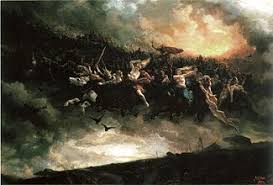
Vampires and zombies are having a long run in contemporary popular culture. But they are only two members of the underground population that refuse to lie quietly for whatever reason. Revenants, those who return from the grave, have always been a problem, judging by the number and variety of traditions about them. The ingenuity of the human animal is well displayed in the many different ways that ghosts, apparitions and related phantasms can be deployed in story. A Russian tale manages to turn the disturbing possibility of the undead into a moral lesson:
The Shroud
In a certain village there was a girl who was lazy and slothful, hated working, but would gossip and chatter away like anything! Well, she took it into her head to invite the other girls to a spinning party. For in the villages, as every one knows, it is the lazybones who gives the spinning feast, and the sweet-toothed are those who go to it.
Well, on the appointed night she got her spinners together. They span for her, and she fed them and feasted them. Among other things they chatted about was this — which of them all was the boldest?
Says the lazybones, “I’m not afraid of anything!”
“Well then,” say the spinners, “if you’re not afraid, go past the graveyard to the church, take down the holy picture from the door, and bring it here.”
“Good, I’ll bring it; only each of you must spin me a distaff-full.”
That was just her sort of notion: to do nothing herself, but to get others to do it for her. Well, she went, took down the picture, and brought it home with her. Her friends all saw that sure enough it was the picture from the church. But the picture had to be taken back again, and it was now the midnight hour. Who was to take it? At length the lazybones said, “You girls go on spinning. I’ll take it back myself. I’m not afraid of anything!”
So she went and put the picture back in its place. As she was passing the graveyard on her return, she saw a corpse in a white shroud, seated on a tomb. It was a moonlight night; everything was visible. She went up to the corpse, and drew away its shroud from it. The corpse held its peace, not uttering a word; no doubt the time for it to speak had not come yet. Well, she took the shroud and went home.
“There!” says she, “I’ve taken back the picture and put it in its place; and, what’s more, here’s a shroud I took away from a corpse.” Some of the girls were horrified; others didn’t believe what she said, and laughed at her.
But after they had supped and lain down to sleep, all of a sudden the corpse tapped at the window and said, “Give me my shroud! Give me my shroud!”
The girls were so frightened they didn’t know whether they were alive or dead. But the lazybones took the shroud, went to the window, opened it, and said, “There, take it.”
“No,” replied the corpse, “restore it to the place you took it from.” Just then the cocks suddenly began to crow. The corpse disappeared.
Next night, when the spinners had all gone home to their own houses, at the very same hour as before, the corpse came, tapped at the window, and cried, “Give me my shroud!”
Well, the girl’s father and mother opened the window and offered him his shroud. “No,” says he, “let her take it back to the place she took it from.”
“Really now, how could one go to a graveyard with a corpse? What a horrible idea!” she replied. Just then the cocks crew. The corpse disappeared.
Next day the girl’s father and mother sent for the priest, told him the whole story, and entreated him to help them in their trouble. “Couldn’t a service be performed?” they said.
The priest reflected awhile; then he replied, “Please tell her to come to church tomorrow.”
Next day the lazybones went to church. The service began, numbers of people came to it. But just as they were going to sing the cherubim song, there suddenly arose, goodness knows whence, so terrible a whirlwind that all the congregation fell flat on their faces. And it caught up that girl, and then flung her down on the ground. The girl disappeared from sight; nothing was left of her but her back hair. [a braid of hair][i]
[i] W. R. S. Ralston, Russian Folk-Tales (London: Smith, Elder, and Company, 1873), pp. 307-309, from Aleksandr Afanasyev, Russian Folk-Tales (from 1855).






